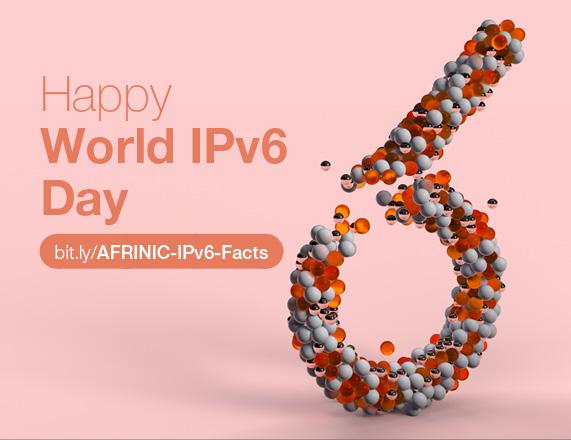Quick facts about IPv6 in Africa
- IPv6 is distributed by the Regional Internet Registry - AFRINIC
- Today, there are 51 countries in Africa with IPv6 resources.
- The top 5 countries with most IPv6 resources are:
South Africa (314 prefixes),
Nigeria (78),
Kenya (58),
Tanzania (50),
Ghana (35)

WHAT IS INTERNET PROTOCOL
IP (Internet Protocol) is the protocol that governs communications on the Internet. In order to connect and communicate, each device (computer, smartphone, tablet, and more.) needs a unique identifier. This identifier is called the IP Address. As of date, we have two versions of IP: IPv4 and IPv6.

What is IPv6
The founders of the Internet decided to use IPv4 addresses to identify devices on the Internet. These IPv4 addresses are coded on 32 bits, which translates to 4.2 billion available addresses. With more and more devices getting online every day, this number is unable to ensure scalability and growth of the Internet. The IPv6 address space was then created by the IETF engineers to solve the problem of IPv4 address depletion.
IPv6 is coded on 128 bits and has 2^128 =
340,282,366,920,938,463,463,374,607,431,768,211,456

Difference between IPv4 and IPv6
- IPv4 is 32-Bit IP address whereas IPv6 is a 128-Bit IP address.
- IPv4 is written in decimal dotted format (192.168.10.1), whereas IPv6 is represented in hexadecimal characters separated by colons (:) (2001:db8:c001:aba::dead).
- IPv6 packet base header has been simplified and now has 8 fields in contrast to IPv4 packet base header with 14 fields.
- In IPv6 there are no more broadcast communications.
- Functions like ARP in IPv4 are now taken care of in IPv6 with a new protocol called NDP(Neighbor Discovery Protocol). This NDP relies on ICMPv6(ICMP for IPv6 with additional messages) messages.
- In IPv4 Packet size of 576 bytes required and fragmentation optional while in IPv6 1208 bytes required without fragmentation.
- Quality of service is better-taken care of in IPv6 with fields in the base header like “traffic class” and “flow label”.
- With Link-local addresses and the Stateless Address Autoconfiguration (SLAAC) IPv6 devices are “almost” plug-n-play.

Why you should adopt IPv6
- Enjoy efficient routing as IPv6 reduces the size of routing tables and makes routing more efficient and hierarchical.
- Experience more efficient packet processing. IPv6's simplified packet header makes packet processing more efficient.
- Get directed data flow using the “Flow Label” field of the IPv6 base header.
- Get simplified network configuration using SLAAC.
- Enjoy support for additional services using the extension header field in the IPv6 packet structure.

How can you connect to IPv6?
You can get your IPv6 space from AFRINIC directly or through your ISP.
Once you have your space, you will have to activate IPv6 on your link with the ISP.
If your ISP does not support IPv6 yet, you can use a tunnel provider online.
If you need support, the AFRINIC deployment helpdesk can assist, fill the form at http://bit.ly/6Deploy-EN
Learning more about IPv6
You can master IPv6 by taking IPv6 courses on the AFRINIC E-learning platform [1]. AFRINIC also organises webinars every month in both French and English. The webinars cover various aspects of IPv6. If you are not yet on our mailing lists, subscribe to receive our webinar announcements at https://www.afrinic.net/email.

Steps of acquiring IPV6 Resources in Africa
To acquire IPv6 Resources, New AFRINIC Members can follow prompts on the link below https://afrinic.net/become-member#eligibility
Existing AFRINIC Members will follow these steps>>
- Log in to https://my.afrinic.net
- Go to Resources -> IPv6 Resources
- Click on "Request New IPv6 Resource"
For more Information
For further questions on IPv6 please write to This email address is being protected from spambots. You need JavaScript enabled to view it.. Supporting FAQ's on IPv6 is available at https://afrinic.net/support/ipv6
Note: As of date, IPv6 address space is free for members with IPv4 blocks.



